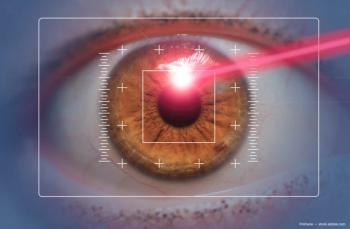
Bimatoprost drug pad-IOL system shows reduction in mean IOP at 24 months
Key Takeaways
- The BIM-IOL system showed a 42% reduction in mean IOP and improved visual acuity, with no serious adverse events linked to the system.
- The system delivers bimatoprost consistently, reducing IOP in patients with open-angle glaucoma or ocular hypertension.
The 24-month results of this first-in-human trial supports the potential long-term outcomes of this system to lower IOP.
Interim 24-month data from a trial of the bimatoprost drug pad-IOL system (BIM-IOL system) showed sustained improvements in intraocular pressure (IOP) and visual acuity outcomes.1
The BIM-IOL system has been developed by SpyGlass Pharma, Inc. The company stated in its press release that the system is a “novel, proprietary non-bioerodible drug pads attached to SpyGlass Pharma’s intraocular lens (IOL).”1 The device is implanted during cataract surgery and is designed “to reduce IOP in patients with open-angle glaucoma (OAG) or ocular hypertension (OHT). The system is designed to consistently deliver multiple years of bimatoprost, a prostaglandin analog approved for the reduction of elevated IOP in patients with OAG or OHT.”1
The data shared by the company is from the single-center, prospective first-in-human trial. The results showed:
- “42% reduction in mean IOP, from 25.1 ± 2.5 mmHg at baseline post-washout to 14.5 ± 3.0 mmHg (p<0.0001), with no statistically significant difference in IOP reduction across the three dosage groups tested.”1
- “100% of patients were off all topical IOP-lowering medications.”1
- “Best corrected distance visual acuity (BCDVA) improved to 20/30 or better in all patients.”1
The company also noted that the system well tolerated by patients with no serious adverse events. No adverse events were associated with the BIM-IOL system and were instead linked to the cataract procedure.1
In 2024, SpyGlass Pharma reported the 1-year data from this study at the American Society of Cataract and Refractive Surgeons (ASCRS) Annual Meeting, which was held from April 5-8, 2024, in Boston, Massachusetts. In the press release issued in alignment with that meeting, the company shared, “One year after implantation, the enduring intraocular pressure (IOP) reduction remained consistent across all three dose strengths, achieving a mean pressure reduction of 44.6% at month 12 compared to pre-operative washed-out baseline levels. All patients sustained more than a 20% IOP reduction from baseline and IOPs of ≤18 mmHg through month 12. Additionally, 100% of patients remain off topical IOP-lowering drops. The SpyGlass platform was well tolerated and there were no adverse events related to the product.”2
References:
SpyGlass Pharma’s Novel BIM-IOL System Demonstrated a Statistically Significant Reduction in Mean IOP at 24 Months. SpyGlass Pharma, Inc. News Release. October 14, 2025. Accessed October 27, 2025.
https://www.globenewswire.com/news-release/2025/10/14/3166153/0/en/SpyGlass-Pharma-s-Novel-BIM-IOL-System-Demonstrated-a-Statistically-Significant-Reduction-in-Mean-IOP-at-24-Months.html SpyGlass Pharma Unveils Compelling 1-Year Data of Its Innovative Drug Delivery Platform Implanted During Routine Cataract Surgery in Eyes with Glaucoma. SpyGlass Pharma, Inc. News Release. April 2, 2024. Accessed October 27, 2025. https://www.globenewswire.com/news-release/2024/04/02/2855881/0/en/SpyGlass-Pharma-Unveils-Compelling-1-Year-Data-of-Its-Innovative-Drug-Delivery-Platform-Implanted-During-Routine-Cataract-Surgery-in-Eyes-with-Glaucoma.html
Newsletter
Don’t miss out—get Ophthalmology Times updates on the latest clinical advancements and expert interviews, straight to your inbox.















































.png)


